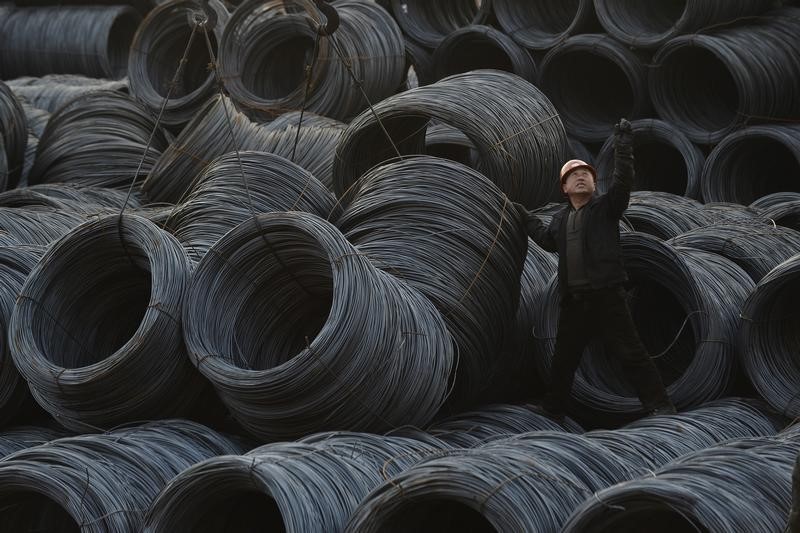(Repeats item issued earlier. The opinions expressed here are those of the author, a columnist for Reuters.)
By Clyde Russell
LAUNCESTON, Australia, Aug 9 (Reuters) - At what point is the 43 percent rally in iron ore prices this year overcooked, given it remains a well-supplied market facing mounting economic uncertainty across the globe.
The answer lies clearly in the volume of Chinese imports of the steel-making ingredient, which have been robust so far this year and defied expectations that growth would be moderate at best.
China, which buys about two-thirds of global seaborne iron ore, imported 88.4 million tonnes in July, the second-highest amount on record, according to customs data. the first seven months of the year China has imported 582 million tonnes of iron ore, up 8.1 percent on the same period in 2015 and putting it on track for full-year imports near 1 billion tonnes, which would be an all-time high.
It's likely that imports will continue to be robust this month, with Thomson Reuters Commodity Research and Forecasts showing that already 67.5 million tonnes will arrive at Chinese ports by Aug. 31.
This likely includes all the cargoes that will come from Brazil and number three supplier South Africa, as any vessels setting sail now would arrive in September, but it won't capture all the shipments from top exporter Australia given the shorter voyage durations.
As long as Chinese iron ore imports remain strong and show year-on-year growth, it's hard to make a convincing case as to why prices should decline.
Spot Asian iron ore .IO62-CNI=SI closed on Monday at $61.40 a tonne, up from $42.90 at the end of the last year and 66 percent above the $37 it slumped to on Dec. 11 last year, the lowest since price assessments started in 2008.
The rally has largely been driven by Chinese imports, which in turn have been rising because steel output has stayed resilient this year, contrary to efforts by the Beijing authorities to remove excess capacity from the industry.
China's average daily crude steel output reached a record 2.316 million tonnes in June, according to government data.
However, while steel output rose in June and over the second quarter, a weak start to the year means production in the first six months of the year was 399.56 million tonnes, 1.1 percent lower than in the same period in 2015.
Nonetheless, June's record average daily steel production was just above the prior all-time high in April, meaning that the two strongest months have both been in the second quarter of 2016.
The question then becomes whether it's reasonable to expect Chinese steel output to continue to show strength over the second half of the year.
STEEL OUTPUT TO LEVEL OFF?
Certainly the authorities are still confident that efforts to curb output will bear fruit, although that may actually boost steel prices assuming demand for construction and infrastructure remains solid.
China's steel exports have also shown little sign of slowing, rising to 67.41 million tonnes in the first seven of the year, up 8.5 percent from the same period in 2015.
It's clear there are fundamental reasons for iron ore's rally, with demand surprising to the upside and supply growth from major producers finally starting to ease.
However, can China actually consume imported iron ore at rates of 1 billion tonnes a year and above?
Logic says not, especially if the authorities do manage to curb, or even reduce, steel output and capacity.
Assuming Chinese steel output of about 800 million tonnes in 2016, which would be above the level the market expected at the start of the year, about 1.2 billion tonnes of iron ore, on a 62-percent iron content basis, will be required.
If 1 billion tonnes comes from the seaborne market, that leaves only 200 million tonnes to be supplied by China's own mines.
That actually may be a reasonable assumption for domestic supplies, given the struggles many miners are facing to remain open given the slump in iron ore prices since 2011, which has only partially been reversed by this year's rally.
However, official data suggests that iron ore output in China is trending higher, with a third straight month of gains in June.
China produced a total of 594 million tonnes of iron ore in the first six months of 2016, according to official figures, suggesting it may reach about 1.2 billion tonnes for the full year.
Given Chinese ore is of a considerably lower grade than imported ore, this would probably equate to less than 400 million tonnes on a 62-percent iron basis.
This means that it's still likely that China's iron ore market will be oversupplied in 2016 when imports and domestic productions are put together.
This may explain why the forward curve of the main iron ore contracts are pointing to considerably weaker prices next year.
The Dalian futures curve 0#DCIO: is showing that prices will fall by almost 18 percent from September to July next year, while the Singapore curve 0#SGXIOS: shows an identical decline, from $62.40 a tonne in September to $49.45 by July.
Of course, futures curves are not absolute predictors of price, but the fact that they expect the rally to fizzle suggests that iron ore miners should make hay while the sun is shining.
(Editing by Richard Pullin)
